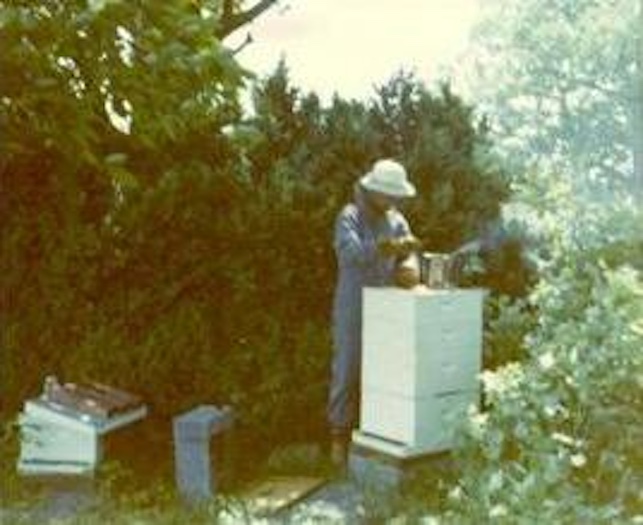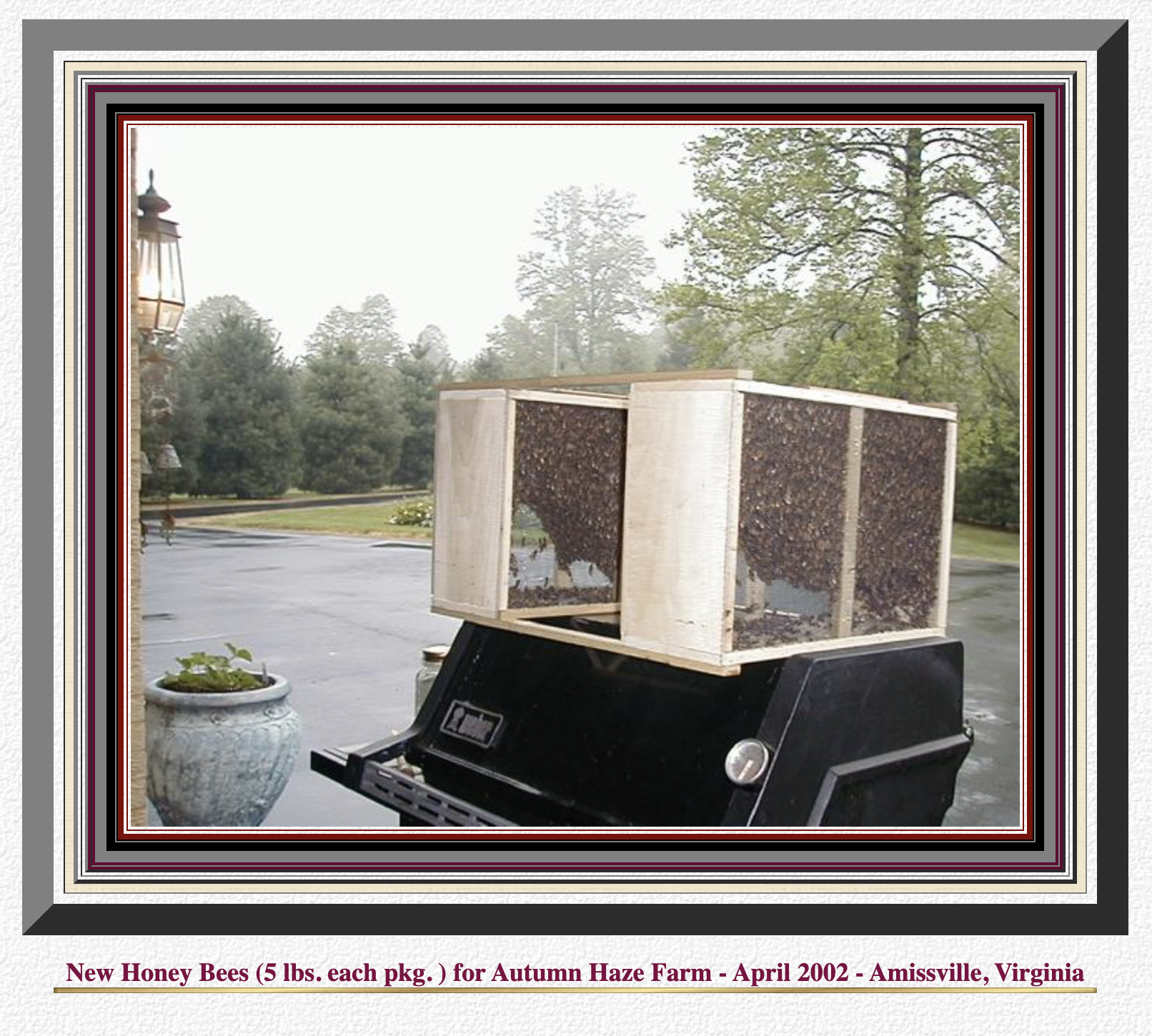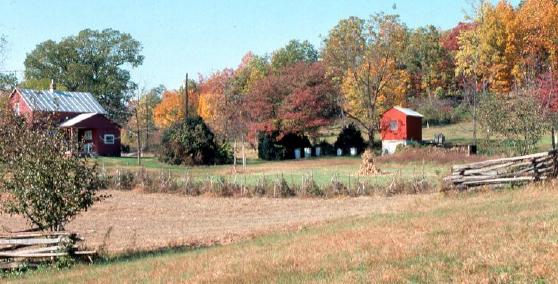

For over 30 years honey bees were raised on the Autumn Haze Farm. Honey was given to family members and neighbors. Of course the bears often got their share of honey.
Chestnut
Oak and Autumn Haze Farm are
located on the edge of a farming
village known as Amissville,
Virginia. American settlers first
permanently settled this area of
rural Virginia in the early
1700s. These settlers were moving
west from the Richmond and
Williamsburg, Virginia areas.
During the early 1700s Indians
still used this area as their
hunting grounds and were not
friendly to the new settlers.
Many of the settlers suffered
death at the hands of these
Indians. Many "Indian
Artifacts
"
can still be found here at
Chestnut Oak and on surrounding
lands.
The civil war sponsored several
battles in the surrounding areas
of Amissville. Old timers have
told me stories of their parents
seeing confederate solders
traveling through the Chestnut
Oak area on their way to cross
the Rappahannock River. I have
found artifacts here at Chestnut
Oak from that era to confirm
their stories. There
was movement by armies of both
sides through the area of
Amissville during the Civil War.
At the time of the settlement of
Jamestown in 1607, this hilly,
wooded Virginia land at the
foothills of the famous Blue
Ridge Mountains was inhabited by
the Manahoacs (Algonquin for they
were known to be very merry)
Indians. The Manahoacs'
prehistoric home was among the
foothills of the Alleghany
Mountains. The Manahoacs were not
agricultural people; they lived
by hunting and made a practice of
firing the forest in order to
kill the trees and hence make
room for grasses for their
favorite game, the buffalo. As
their hunting grounds were
invaded by the early settlers,
these Indians retaliated by
making many destructive raids on
the settlers. This prompted Lord
Howard, on becoming governor of
Virginia, to negotiate a treaty
with them in 1684. This treaty in
effect constituted a concession
of the eastern slopes of the Blue
Ridge Mountains and the land west
of the Blue Ridge to the Iroquois
Indians in return for immunity
from molestation to the
settlements already established
below the falls of the rivers.
Because of this covenant, no
official colonization was
possible until the treaty of
Albany in 1722, which opened up
the Piedmont section of Virginia
to settlement.
By 1700, the total population of
Virginia was only about 70,000. A
majority of these settlers were
small farmers who constantly
encroached upon Indian lands in
the Rappahannock region. In
effect this part of Virginia
became the "First
Frontier". The
"WEST" had now appeared
in American history. Settlement
of this immediate area began in
about 1730. This area, to be
known as Rappahannock, did not
emerge until 1833. It acquired
its name from the famous
Rappahannock River. In
Rappahannock County some of the
homes of the "First
Frontiersman" still stand,
occupied in some instances by
descendants of the first
settlers. Here at Chestnut Oak, a
1750 log cabin relic is still
standing on Jobbers Mountain.
Descendants of the Poe Family,
who originally built this home,
occupied it until 1913. It is
representative of the homes of
the 1700 era that were built on
the "new" frontier. An
excellent representation of
cabins, mansions, and houses
built during the first one
hundred fifty years of settlement
can be found in the vicinity of
Chestnut Oak and throughout
Rappahannock County.
Amissville: This scattered
village grew along the Waterloo
road on grants made by Lord
Fairfax to Joseph Bayse and
Joseph Amiss in 1763; acquiring
the name of Amissville when the
Amiss faction won over the Bayses
by one vote in an election to
name the village. The Amissville
Post Office was established on
October 2, 1810, with the first
postmaster Thomas Amiss.
There are several 18th
century homes in and around
Amissville, the oldest being the
Baker cottage next to the
Methodist Church. The Luttrels,
Singletons, Corbins and Bywarters
settled this part of the country,
the latter two to the South of
the Amiss grant along the Thorton
River. It is reported that
Amissville became a part of
Rappahannock County in 1833. In
August, 1670, Francis Lederer had
explored the area from the Great
Fork, the juncture of the
Rappahannock and Rapidan Rivers,
to the Blue Ridge, and marked
trails. In the mid 1700s, William
Poe, who had land in the upper
reaches of Battle Run as far back
as 1737, and lived near Gaines
Cross Roads, laid off a road
which roughly followed John Lederer's
Trail that he traveled in 1670. It is represented by the
present Route 637 from Route 211
west of Amissville to a spot
near Wakefield Manor on Route 522,
between Flint Hill and Huntly.
A
Amissville son of the original
Luttrell family ( Dr.
Homer Browning Luttrell )
was my parent's family medical
doctor in a coal mining community
in West Virginia and was my
doctor as a small child; over
75 years ago. Dr. Luttrell
lived to be 97 years old and died
on July 2, 1992. He was well known
for his work as a pioneer coal
company doctor at Buckeye Coal
and Coke Company in Freeman, WV
during the 1920s and 30s.
Luttrell descendants still reside
in Amissville,Virginia.
Chestnut Oak: Chestnut Oak is
located on Rt. 637, two miles
from the Amissville village. This
rural area was once referred to
as Hedgesville. Chestnut Oak is
named after a large
(approximately two hundred years
old) "Chestnut Oak"
tree that still stands beside to
the old "Autumn Haze
Farm" house. This farmhouse
is representative of the Virginia
"common folk" houses
that were built at the turn of
the 19th century. It is
constructed from rough cut timber
from the surrounding forest and
is supported with water from a
twenty-six foot deep (hand dug)
well. An old fashion metal roof
covers the house. It was built by
the Wes Peyton Family in the
early 1900s and remains in a
restored condition. From this
beautiful Autumn Haze Farm
setting one can only imagine
living conditions that existed in this
rural Virginia country side
one hundred years ago.
The fertile soil at Autumn Haze
offers exceptionally good
gardening and has served as
farmland for the past one hundred
fifty years. An abundant amount
of fruits and vegetables are
still grown here each year. The
surrounding hilly woodlands and
fields also offer refuge to an
abundant amount of wild life;
including white tail deer, black
bear, wild turkey, grouse, and
the usual amount of fox, rabbit
and numerous other small game. A
stocked pond offers
good fishing and exceptional
relaxation.
(The author credits the above
early Virginia history to the
Rappahannock County,
Virginia.."The first
Frontier" brochure as
published in 1957.)

Autumn
Haze Farm
|

 History Of Chestnut Oak .
History Of Chestnut Oak .


 History Of Chestnut Oak .
History Of Chestnut Oak .

